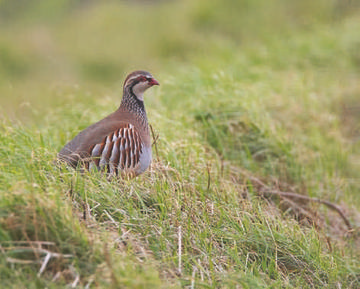
Red-legged Partridge © Richard Steel
For such a sedentary species, there would be expected to be little difference between the breeding and wintering distribution maps, but 67 tetrads held Red-legged Partridges in the breeding season only, and 31 in winter only. This could be explained by birds gathering into flocks for the winter, but they normally stay together as family groups, typically two to five adults and their young (Brown & Grice 2005). This species differs from the Grey Partridge in that young males stay with the family party and it is the young females that disperse to avoid inbreeding: only about one quarter of young males move more than 0.5 km, while about three-quarters of yearling females do so (Migration Atlas). The ‘difference’ map shows that almost all of the tetrads occupied in winter only were adjacent to one with breeding season presence, and only three tetrads were more than 5 km away. The loss of birds from some of the more isolated breeding sites is difficult to explain, however.
91% of winter habitat records were on farmland, with similar proportions to the breeding season, 34% improved grassland, 7% unimproved grassland, 13% tilled land and 13% mixed grassland and tilled land. The hedge categories make up much of the remainder, but 7% of records were on stubble. Their winter diet is much the same as that of Grey Partridge, mainly seeds of grain and weeds, especially Polygonum, but birds increasingly turn to green food as seed becomes scarcer through the winter, particularly the shoots of winter-sown cereals.
Half of the submitted counts were of four birds or fewer, with 21 records of ten birds or more. The largest was 35 birds High Legh (SJ78B), with 28 near Marton in SJ86J, both in 2005/ 06. The same winter, twenty birds walked casually through Alan Straw’s rural garden near Mow Cop (SJ85U).
Sponsored by Jim Bell

